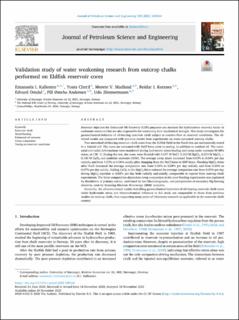| dc.contributor.author | Kallesten, Emanuela Iedidia | |
| dc.contributor.author | Cherif, Yosra | |
| dc.contributor.author | Madland, Merete Vadla | |
| dc.contributor.author | Korsnes, Reidar Inge | |
| dc.contributor.author | Omdal, Edvard | |
| dc.contributor.author | Andersen, Pål Østebø | |
| dc.contributor.author | Zimmermann, Udo | |
| dc.date.accessioned | 2021-04-29T06:38:48Z | |
| dc.date.available | 2021-04-29T06:38:48Z | |
| dc.date.created | 2020-11-18T19:42:38Z | |
| dc.date.issued | 2020-03 | |
| dc.identifier.citation | Kallesten, E.I., Cherif, Y., Madland, M.V. et al. (2021) Validation study of water weakening research from outcrop chalks performed on Eldfisk reservoir cores. Journal of Petroleum Science and Engineering, 198, 108164 | en_US |
| dc.identifier.issn | 0920-4105 | |
| dc.identifier.uri | https://hdl.handle.net/11250/2740252 | |
| dc.description.abstract | Seawater injection for Enhanced Oil Recovery (EOR) purposes can increase the hydrocarbon recovery factor in carbonate reservoirs but are also responsible for weakening their mechanical strength. This study investigates the geomechanical behavior of oil-bearing reservoir chalk subject to reactive flow at reservoir conditions. The obtained results are compared with previous results from experiments on water-saturated outcrop chalks.
Two unwashed oil-bearing reservoir chalk cores from the Eldfisk Field in the North Sea are mechanically tested in a triaxial cell. The cores are saturated with NaCl brine prior to testing, in addition to residual oil. The cores’ axial and radial deformations were monitored during hydrostatic stress loading and creep under constant 50 MPa stress, at 130 °C. During the test, the cores were flooded with 0.657 M NaCl, 0.219 M MgCl2, 0.219 M MgCl2 + 0.130 M CaCl2 and synthetic seawater (SSW). The average creep strain increased from 0.03% to 0.04% per day radially and from 0.03% to 0.06% axially after changing from the NaCl brine to SSW brine. Flooding MgCl2 brine after NaCl increased the average compaction rate from 0.05% to 0.09% per day radially and from 0.04% to 0.07% per day axially. Adding CaCl2 to the MgCl2 brine reduced the average compaction rate from 0.05% per day during MgCl2 injection to 0.02% per day both radially and axially, comparable to reports from outcrop chalk experiments. The brine composition-dependent creep compaction in the core flooding experiments was explained by dissolution of primary calcite, confirmed by Ion Chromatography, and precipitation of secondary Mg-bearing minerals, seen by Scanning Electron Microscopy (SEM) analytics.
Generally, the aforementioned results describing geomechanical behaviors of oil-bearing reservoir chalk cores under hydrostatic stress and thermochemical influence in this study are comparable to those from previous studies on outcrop chalk, thus supporting many years of laboratory research as applicable in the reservoir chalk context. | en_US |
| dc.language.iso | eng | en_US |
| dc.publisher | Elsevier Ltd. | en_US |
| dc.rights | Navngivelse 4.0 Internasjonal | * |
| dc.rights.uri | http://creativecommons.org/licenses/by/4.0/deed.no | * |
| dc.subject | petroleumsteknologi | en_US |
| dc.subject | EOR | en_US |
| dc.subject | petroleum engineering | en_US |
| dc.title | Validation study of water weakening research from outcrop chalks performed on Eldfisk reservoir cores | en_US |
| dc.type | Peer reviewed | en_US |
| dc.type | Journal article | en_US |
| dc.description.version | publishedVersion | en_US |
| dc.rights.holder | © 2020 The Authors. | en_US |
| dc.subject.nsi | VDP::Teknologi: 500::Berg‑ og petroleumsfag: 510::Petroleumsteknologi: 512 | en_US |
| dc.source.volume | 198 | en_US |
| dc.source.journal | Journal of Petroleum Science and Engineering | en_US |
| dc.identifier.doi | 10.1016/j.petrol.2020.108164 | |
| dc.identifier.cristin | 1849533 | |
| dc.relation.project | Norges forskningsråd: 230303 | en_US |
| dc.source.articlenumber | 108164 | en_US |
| cristin.ispublished | false | |
| cristin.fulltext | postprint | |
| cristin.qualitycode | 2 | |

